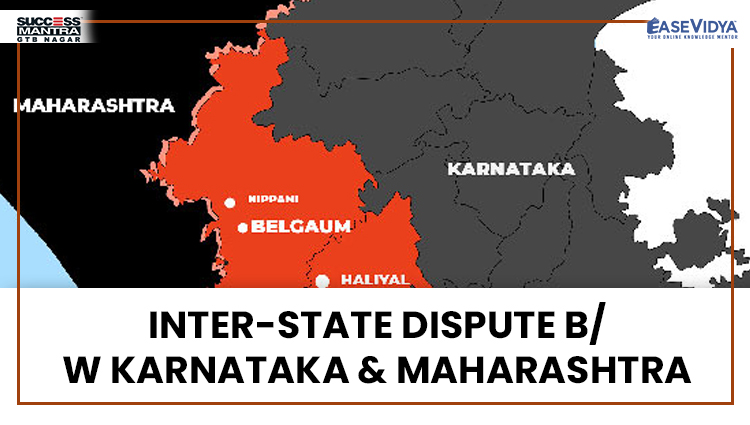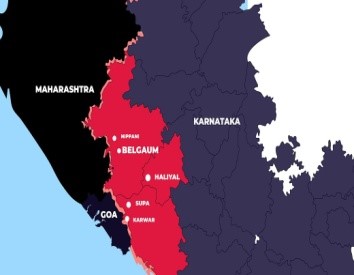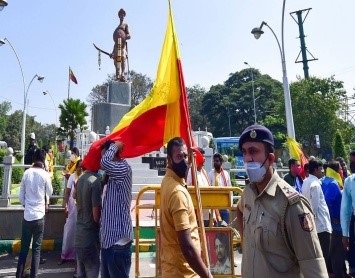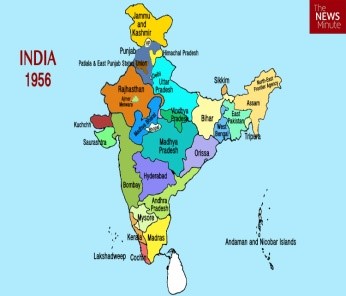
INTER STATE DISPUTE BETWEEN KARNATAKA AND MAHARASHTRA
INTER-STATE DISPUTE B/W KARNATAKA & MAHARASHTRA
An inter-state dispute between Karnataka and Maharashtra dating back to the period of Independence and the reorganization of states on linguistic lines in 1956 have reared its head again in the Belagavi region of Karnataka. The latest flashpoint is following a series of minor incidents over the last weeks that have inflamed pro-Kannada and pro-Marathi passions on the two sides of the border. The Maharashtra Ekikaran Samiti – a socio political party representing the interests of the Marathi-speaking population in the Belagavi region with the single-point agenda of unifying Marathi-speaking villages in Belagavi with Maharashtra (in opposition to the reorganization of states in 1956) – is pitted against pro-Kannada groups in Karnataka who believe Belagavi is now a Kannada-speaking district. With mainstream political parties in Maharashtra and Karnataka tending to take a partisan position, with their Marathi and Kannada-speaking vote bases in mind, the issue has in the past generated political heat on both sides of the border.

Current Affairs Notes By Success Mantra Coaching Institute GTB Nagar Delhi CLICK HERE
ABOUT THE DISPUTE
In 1957, slighted by the implementation of the States Reorganization Act, 1956, Maharashtra demanded readjustment of its border with Karnataka. Maharashtra invoked Section 21 (2) (b) of the Act and submitted a memorandum to the Ministry of Home Affairs stating its objection to Marathi- speaking areas being added to Karnataka. It claimed an area of 2,806 square miles that involved 814 villages, and three urban settlements of Belagavi, Karwar and Nippani with a total population of about 6.7 lakh, all part of the Mumbai Presidency before independence. The villages are spread across Belagavi and Uttar Kannada in north-western Karnataka, and Bidar and Gulbarga districts in north-eastern Karnataka — all bordering Maharashtra. Later, when a four-member committee was formed by both States, Maharashtra expressed willingness to transfer predominantly Kannada-speaking 260 villages with a population of about 3.25 lakh and total area of 1,160 square miles. This was in lieu of accepting its demand for 814 villages and three urban settlements, which was turned down by Karnataka.
BASIS OF MAHARASHTRA & KARNATAKA CLAIM:
Maharashtra's Position: Maharashtra’s claim to seek the readjustment of its border was on the basis of contiguity, relative linguistic majority and wishes of the people. If the claim over Belagavi and surrounding areas was based on Marathi-speaking people and linguistic homogeneity, it laid its claim over Karwar and Supa where Konkani is spoken by citing Konkani as a dialect of Marathi. Its argument was based on the theory of villages being the unit for calculation and enumerated linguistic population in each village. Maharashtra also points out the historical fact that the revenue records in these Marathi-speaking areas are also kept in Marathi.
Karnataka’s Position: Karnataka has argued that the settlement of boundaries as per the States Reorganization Act is final. The boundary of the State was neither tentative nor flexible. The State argues that the issue would reopen border issues that have not been contemplated under the Act, and that such a demand should not be permitted.

STEPS TAKEN TO RESOLVE THE ISSUE
- In 1960, both States agreed to set up a four-man committee with two representatives from each State. Except on the issue of contiguity, the committee could not arrive at a unanimous decision. Between the 1960s and 1980s, chief ministers of Karnataka and Maharashtra have met several times to find a solution to the vexed issue but with no avail.
- Response of Union Government: The central government constituted the Mahajan Committee in 1966 to assess the situation. Representatives from both sides, Maharashtra and the then Mysore state were part of the committee. In 1967, the committee recommended that some villages in Karwar, Haliyal and Suparna talukas of Karnataka be given to Maharashtra but left Belagavi with the southern state.
- Response of the Supreme Court: In 2006, the Supreme Court held that the issue should be resolved through mutual negotiation and that linguistic criterion should not be considered as it may create more practical problems..The case is still being heard by the Supreme Court.
Other Border Disputes between Different States:
- Boundary issue between Assam and Mizoram
- Odisha’s Border Disputes
REORGANIZATION OF STATES IN INDIA
At the time of independence in 1947, India consisted of nearly 550 disjointed princely states. In 1950, the Constitution contained a four-fold classification of the states of the Indian Union—Part A, Part B, Part C and Part D States.
- Part-A states comprised nine erstwhile governor’s provinces of British India.
- Part-B states consisted of nine erstwhile princely states with legislatures.
- Part-C states consisted of the erstwhile chief commissioner’s province of British India and some of the erstwhile princely states.
- Part-D state comprised the Andaman and Nicobar Islands only.
The grouping of states at the time was done on the basis of political and historical considerations rather than on linguistic or cultural divisions, but this was a temporary arrangement. On account of the multilingual nature and differences that existed between various states, there was a need for the states to be reorganized on a permanent basis. In this context, in 1948, SK Dhar committee - was appointed by the government to look into the need for the reorganization of states on a linguistic basis. The Commission preferred reorganization of states on the basis of administrative convenience including historical and geographical considerations instead of on linguistic lines. This created much resentment and led to the appointment of another Linguistic Provinces Committee.
In December 1948, the JVP Committee comprising Jawaharlal Nehru, Vallabh Bhai Patel and Pattabhi Sitaramayya was formed to study the issue..The Committee, in its report submitted in April 1949, rejected the idea of reorganization of states on a linguistic basis but said that the issue could be looked at afresh in the light of public demand. However, due to protests, in October 1953, the Government of India created the first linguistic state, known as Andhra state, by separating the Telugu speaking areas from the Madras state. On 22nd December 1953, Jawaharlal Nehru appointed a commission under Fazl Ali to consider the reorganization of states. The commission submitted its report in 1955 and it suggested that the whole country be divided into 16 states and three centrally administered areas. The government, while not agreeing with the recommendations entirely, divided the country into 14 states and 6 union territories under the States Reorganization Act that was passed in November 1956.
Even after the large-scale reorganization of the states in 1956, the political map of India underwent continuous changes due to the pressure of popular agitations and political conditions. On 5th August 2019, President of India in the exercise of the powers conferred by Clause (1) of Article 370 of the Constitution had issued the Constitution (Application to Jammu and Kashmir) Order, 2019.
This divided the state of Jammu and Kashmir into two new Union Territories (UTs): Jammu & Kashmir, and Ladakh. Recently, Dadra and Nagar Haveli and Daman and Diu (Merger of Union Territories) Act, 2019 have merged the Union Territories (UTs) of Daman and Diu (D&D) and Dadra and Nagar Haveli (DNH). Presently, India comprises 28 states and 8 union territories.

PRAVAHINI Current Affairs Notes By Success Mantra Coaching Institute GTB Nagar Delhi CLICK HERE
TEST YOURSELF
Q.1 Recently which of the following books has been released by the CM of Maharashtra which talks about the Maharashtra-Karnataka border dispute that should be replaced with {1}?
- Maharashtra-Karnataka Boundary Dispute: Struggle and Pledge: ANSWER
- Battle between the two States on borders.
- Conflict & Dispute: Maharashtra-Karnataka border issue
- None of the above
Q.2 By which of the following reorganization Act The States Reorganization Act Belgaum, the disputed was made a part of the then Mysore State which was renamed Karnataka?
- State Reorganization Act, 1960
- Bombay Reorganization Act, 1960
- States Reorganization Act, 1956: ANSWER
- Karnataka State Reorganization Act, 1973
Q.3 Consider the following statements and state which of the following is correct in the context of the Maharashtra-Karnataka border dispute?
- The disputed area is Belgaum, which was later renamed Belagavi, is located in the northern part of today’s Karnataka and shares a border with Maharashtra’s Ratnagiri district.
- During the British Raj or the colonial times the Belgaum region was part of the Bombay Presidency which included many parts of Karnataka.
- Only I follows
- Only II follow: ANSWER
- Both I and II are correct
- None is correct
Q.4 Which of the following commissions was formed by the Union Government to look into the issue of Maharashtra-Karnataka border dispute?
- Athreya Commission
- N. Vohra Commission
- Kelkar Commission
- Mahajan Commission: ANSWER
Q.5 After considering the given statements, which of the following is incorrect in the reference to the above passage?
- The Mahajan commission rejected Maharashtra’s claim over Belagavi or the Belgaum District.
- In 2004, the Maharashtra government moved the Supreme Court against the recommendations of the Commissions under Article 131(b).
- Article 131 (b) talks about the setting up of an Inter-state Border Dispute Council: ANSWER
- None of the above












cielfvdd
Latest News on Education & LAW Exams Blogs | Success Mantra cielfvdd http://www.gp37et6s7dxb4798ziyf2g58051nr0v4s.org/ <a href="http://www.gp37et6s7dxb4798ziyf2g58051nr0v4s.org/">acielfvdd</a> [url=http://www.gp37et6s7dxb4798ziyf2g58051nr0v4s.org/]ucielfvdd[/url]
ibhjiteg
Latest News on Education & LAW Exams Blogs | Success Mantra ibhjiteg http://www.g84500y7x0hur6wi3h04ex20i5f33fzps.org/ [url=http://www.g84500y7x0hur6wi3h04ex20i5f33fzps.org/]uibhjiteg[/url] <a href="http://www.g84500y7x0hur6wi3h04ex20i5f33fzps.org/">aibhjiteg</a>